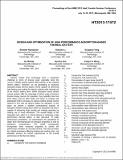| dc.contributor.author | Narayanan, Shankar | |
| dc.contributor.author | Li, Xiansen | |
| dc.contributor.author | Yang, Sungwoo | |
| dc.contributor.author | McKay, Ian | |
| dc.contributor.author | Kim, Hyunho | |
| dc.contributor.author | Wang, Evelyn N. | |
| dc.date.accessioned | 2020-05-12T20:29:57Z | |
| dc.date.available | 2020-05-12T20:29:57Z | |
| dc.date.issued | 2013-07 | |
| dc.identifier.isbn | 978-0-7918-5547-8 | |
| dc.identifier.uri | https://hdl.handle.net/1721.1/125192 | |
| dc.description.abstract | Electric vehicle (EV) technology faces a substantial challenge in terms of driving range, especially when the vehicle's climate control system relies entirely on the onboard electric battery. Therefore, we are developing an advanced adsorption-based thermal battery (ATB) capable of delivering both heating and cooling for electric vehicles with minimal use of the electric battery bank. While adsorption based climate control systems offer the advantage of direct usage of primary thermal energy sources for operation, they typically have low COP values, and are often bulky and heavy. A compact and lightweight ATB is necessary to replace existing climate control systems in EVs that use electric battery for operation. In this paper, we present a detailed computational analysis of adsorption kinetics taking place within an adsorption bed that is capable of delivering large cooling and heating capacities by making use of novel adsorbents. The overall design of the adsorption bed, which is a critical element in achieving a high performance thermal battery, is also discussed. To make performance predictions, we characterized the adsorbents to obtain their thermophysical and transport properties as well as adsorption characteristics. The model consequently incorporates these measured properties to predict the performance variation as a function of time. This work provides the critical parameters affecting heating and cooling rates, and identifies avenues for further improvement in the overall performance of the thermal battery. | en_US |
| dc.publisher | ASME International | en_US |
| dc.relation.isversionof | http://dx.doi.org/10.1115/HT2013-17472 | en_US |
| dc.rights | Article is made available in accordance with the publisher's policy and may be subject to US copyright law. Please refer to the publisher's site for terms of use. | en_US |
| dc.source | ASME | en_US |
| dc.title | Design and Optimization of High Performance Adsorption-Based Thermal Battery | en_US |
| dc.type | Article | en_US |
| dc.identifier.citation | Narayanan, Shankar, Xiansen Li, Sungwoo Yang, Ian McKay, Hyunho Kim, and Evelyn N. Wang. “Design and Optimization of High Performance Adsorption-Based Thermal Battery.” Volume 1: Heat Transfer in Energy Systems; Thermophysical Properties; Theory and Fundamental Research in Heat Transfer (July 14, 2013). Copyright © 2013 by ASME. | en_US |
| dc.contributor.department | Massachusetts Institute of Technology. Department of Mechanical Engineering | en_US |
| dc.relation.journal | Proceedings of the ASME 2013 Heat Transfer Summer Conference | en_US |
| dc.eprint.version | Final published version | en_US |
| dc.type.uri | http://purl.org/eprint/type/ConferencePaper | en_US |
| eprint.status | http://purl.org/eprint/status/NonPeerReviewed | en_US |
| dc.date.updated | 2019-01-09T18:13:19Z | |
| dspace.orderedauthors | Narayanan, Shankar; Li, Xiansen; Yang, Sungwoo; McKay, Ian; Kim, Hyunho; Wang, Evelyn N. | en_US |
| dspace.embargo.terms | N | en_US |
| dspace.date.submission | 2019-04-04T10:55:03Z | |
| mit.license | PUBLISHER_POLICY | en_US |
| mit.metadata.status | Complete | |
